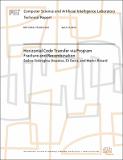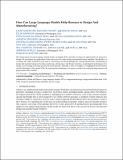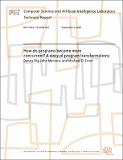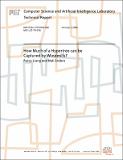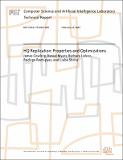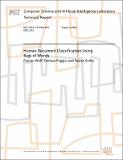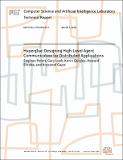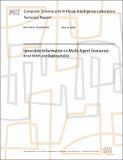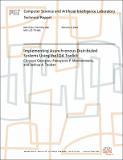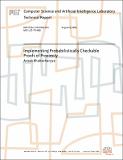Browsing CSAIL Technical Reports (July 1, 2003 - present) by Title
Now showing items 319-338 of 775
-
A hierarchical model of peripheral vision
(2011-06-17)We present a peripheral vision model inspired by the cortical architecture discovered by Hubel and Wiesel. As with existing cortical models, this model contains alternating layers of simple cells, which employ tuning ... -
Hierarchical Task and Motion Planning in the Now
(2010-05-07)In this paper we outline an approach to the integration of task planning and motion planning that has the following key properties: It is aggressively hierarchical. It makes choices and commits to them in a top-down fashion ... -
High Spatial Resolution BRDFs with Metallic powders Using Wave Optics Analysis
(2013-04-24)This manuscript completes the analysis of our SIGGRAPH 2013 paper "Fabricating BRDFs at High Spatial Resolution Using Wave Optics" in which photolithography fabrication was used for manipulating reflectance effects. While ... -
Horizontal Code Transfer via Program Fracture and Recombination
(2015-04-14)We present a new horizontal code transfer technique, program fracture and recombination, for automatically replacing, deleting, and/or combining code from multiple applications. Benefits include automatic generation of new ... -
How do programs become more concurrent? A story of program transformations
(2008-09-05)For several decades, programmers have relied onMooreâ s Law to improve the performance of their softwareapplications. From now on, programmers need to programthe multi-cores if they want to deliver efficient code. Inthe ... -
How Much of a Hypertree can be Captured by Windmills?
(2005-01-03)Current approximation algorithms for maximum weight {\em hypertrees} find heavy {\em windmill farms}, and are based on the fact that a constant ratio (for constant width $k$) of the weight of a $k$-hypertree can be captured ... -
How People Re-find Information When the Web Changes
(2004-06-18)This paper investigates how people return to information in a dynamic information environment. For example, a person might want to return to Web content via a link encountered earlier on a Web page, only to learn that the ... -
How to Construct a Correct and Scalable iBGP Configuration
(2005-08-03)The Border Gateway Protocol (BGP), the current inter domain routing protocol in the Internet, has two modes of operation: eBGP (External BGP), used to exchange routing information between autonomous systems, and iBGP ... -
HQ Replication: Properties and Optimizations
(2007-02-12)There are currently two approaches to providing Byzantine-fault-tolerant state machine replication: a replica-based approach, e.g., BFT, that uses communication between replicas to agree on a proposed ordering of requests, ... -
Human Document Classification Using Bags of Words
(2006-08-09)Humans are remarkably adept at classifying text documents into cate-gories. For instance, while reading a news story, we are rapidly able to assess whether it belongs to the domain of finance, politics or sports. Automating ... -
Hyperglue: Designing High-Level Agent Communication for Distributed Applications
(2006-03-01)We are building a new communication model and discoverysystem which will allow agent-based intelligent spacesto interact with one another. This new infrastructure layer,called Hyperglue, coordinates agent actions at a ... -
A hypothesis-based algorithm for planning and control in non-Gaussian belief spaces
(2011-08-27)We consider the partially observable control problem where it is potentially necessary to perform complex information-gathering operations in order to localize state. One approach to solving these problems is to create ... -
iBCM: Interactive Bayesian Case Model Empowering Humans via Intuitive Interaction
(2015-04-01)Clustering methods optimize the partitioning of data points with respect to an internal metric, such as likelihood, in order to approximate the goodness of clustering. However, this internal metric does not necessarily ... -
Identifying Expression Fingerprints using Linguistic Information
(2005-11-18)This thesis presents a technology to complement taxation-based policy proposals aimed at addressing the digital copyright problem. Theapproach presented facilitates identification of intellectual propertyusing expression ... -
Ignorable Information in Multi-Agent Scenarios
(2008-05-12)In some multi-agent scenarios, identifying observations that an agent can safely ignore reduces exponentially the size of the agent's strategy space and hence the time required to find a Nash equilibrium. We consider games ... -
iJam: Jamming Oneself for Secure Wireless Communication
(2010-06-07)Wireless is inherently less secure than wired networks because of its broadcast nature. Attacks that simply snoop on the wireless medium successfully defeat the security of even 802.11 networks using the most recent security ... -
Implementing Asynchronous Distributed Systems Using the IOA Toolkit
(2004-10-06)This document is a report about the capabilities and performance of the IOA Toolkit, and in particularthe tools that provide support for implementing and running distributed systems (checker,composer, code generator). The ... -
Implementing Atomic Data through Indirect Learning in Dynamic Network
(2006-10-12)Developing middleware services for dynamic distributed systems, e.g., ad-hoc networks, is a challenging task given that suchservices must deal with communicating devices that may join and leave the system, and fail or ... -
Implementing Probabilistically Checkable Proofs of Proximity
(2005-08-08)Abstract: In this paper, we describe a proof-of-concept implementation of the probabilistically checkable proof of proximity (PCPP) system described by Ben-Sasson and Sudan in \\cite{bs05}. In particular, we implement a ...




